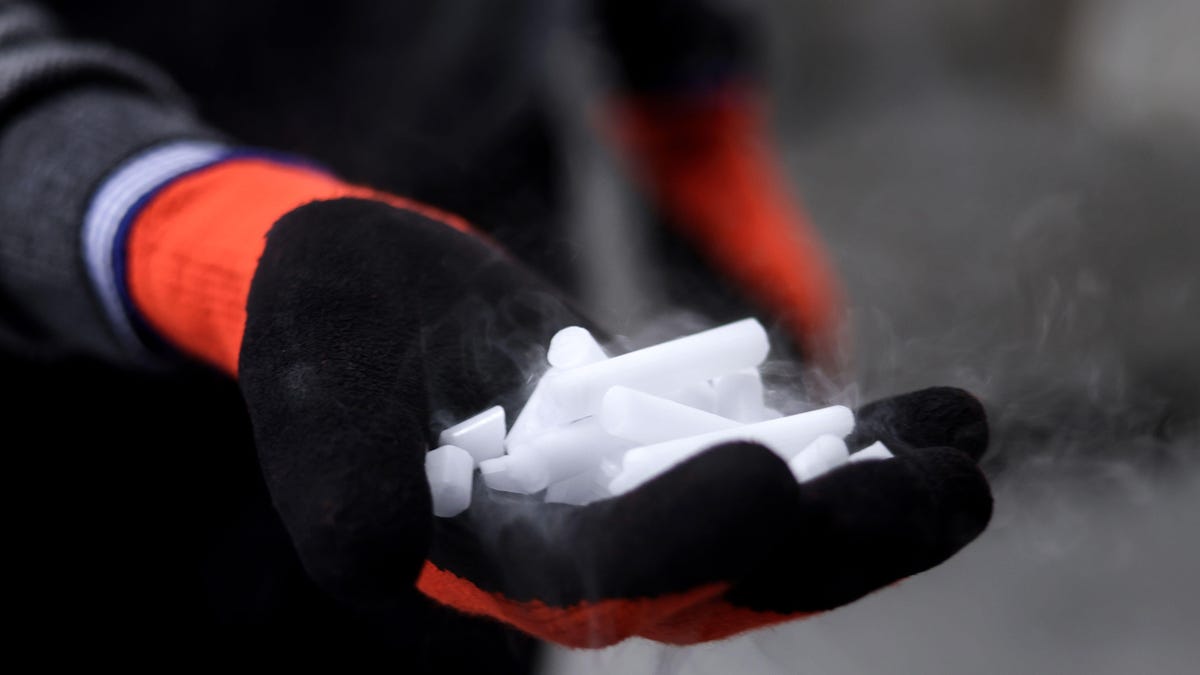What is dry ice and why is it suddenly so important?
Dry ice will help end the coronavirus pandemic. Here's how.

Dry ice has a surface temperature of -109.3 degrees Fahrenheit (-78.5 degrees Celsius).
You've probably heard of dry ice before -- or maybe even made some yourself. But lately, dry ice has become a focal point in the news, due to its unique ability to help keep things very cold in transit without the same melted mess as regular ice. The Pfizer COVID-19 vaccine must be stored at a temperature of -94 degrees Fahrenheit (-70 degrees Celsius), and dry ice will play a crucial role in maintaining the correct temperature as the vaccine travels for distribution. In the United States, there are currently 14.8 million reported cases of COVID-19 and over 282,000 deaths, with the numbers expected to continue to climb during the holiday season amid record-high hospitalizations.
But before we delve further into the coronavirus pandemic and COVID-19 vaccine storage, what exactly is dry ice?
What is dry ice?
Dry ice is solid carbon dioxide. At its surface temperature of -109.3 degrees Fahrenheit (-78.5 degrees Celsius), a frozen block of dry ice transforms directly into a gas, skipping the liquid phase entirely. Because it doesn't melt, and because it can be formed in solid blocks or pellets, it's already a popular choice for shipping certain foods and medicines.
Despite its many benefits as a refrigerant, dry ice must be handled properly or it poses health risks. Because it's so cold, insulated clothing and gloves should be worn when handling it, and it should never be touched directly, as it can "burn the skin similar to frostbite," according to the New York Department of Health. Proper ventilation is also important because too much exposure to carbon dioxide, particularly in enclosed spaces, can be dangerous.
Dry ice and the Pfizer vaccine
Pfizer and Moderna are leading the charge on COVID-19 vaccines, with the US approving the Pfizer vaccine on Dec. 11, after the UK already approved the same vaccine for use. While the Moderna vaccine can survive in a temperature range of 36 to 46 degrees Fahrenheit (2 to 8 degrees Celsius) for up to 30 days, the Pfizer vaccine must be stored at -94 degrees Fahrenheit (-70 degrees Celsius) to remain stable -- which requires more advanced refrigeration. Pfizer and partner BioNTech have said they will be able to provide as many as 50 million vaccine doses this year, followed by up to 1.3 billion vaccine doses by the end of 2021.
That's where dry ice comes in, to ensure that the correct temperatures are maintained for the Pfizer vaccine during its transportation and subsequent storage as it ramps up for distribution. Pfizer's detailed distribution plans include close management of the vaccine along the supply chain, or the cold chain, in the case of safely managing the transportation, storage and distribution of items that must be kept at certain temperatures.
"Our distribution is built on a flexible, just-in-time system, which will ship the frozen vials direct to the point of vaccination," Pfizer states in its US vaccine distribution fact sheet. It plans to ship its vaccines from Kalamazoo, Michigan and Pleasant Prairie, Wisconsin directly to hospitals, pharmacies and anywhere else the vaccine will be administered using "specially designed, temperature-controlled thermal shippers utilizing dry ice to maintain recommended storage temperature conditions of -70 degrees C ±10 degrees C for up to 10 days unopened." Pfizer will also use thermal sensors with GPS capabilities to try to avoid any potential delays during shipping.
Once the vaccines reach their destination, Pfizer says they can be refrigerated for up to five days in a warmer temperature range of 36 to 46 degrees Fahrenheit (2 to 8 degrees Celsius) -- the same range as the Moderna vaccine. Once thawed, the Pfizer vaccines can't be frozen again.
To learn more about the current status of the COVID-19 vaccines, when you might get yours and more, check out this detailed explainer: COVID-19 vaccine: Everything you need to know.

